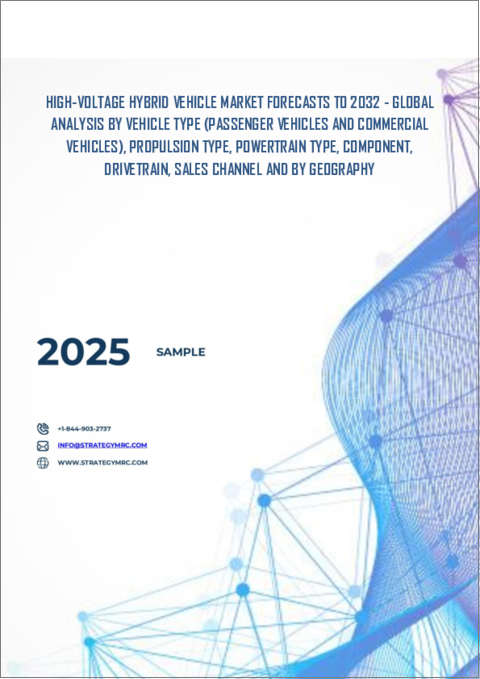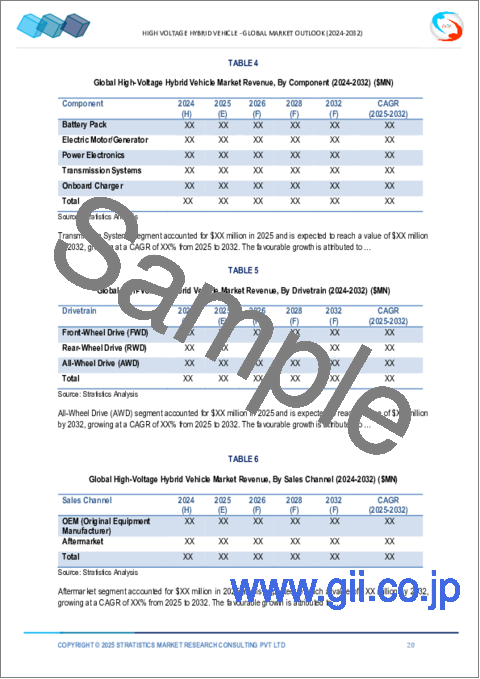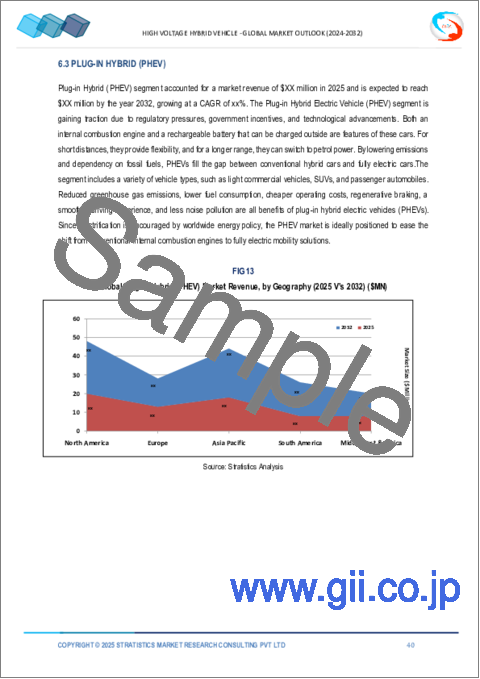|
|
市場調査レポート
商品コード
1734880
高電圧ハイブリッド車市場の2032年までの予測: 車両タイプ別、推進タイプ別、パワートレインタイプ別、コンポーネント別、ドライブトレイン別、販売チャネル別、地域別の世界分析High-Voltage Hybrid Vehicle Market Forecasts to 2032 - Global Analysis By Vehicle Type (Passenger Vehicles and Commercial Vehicles), Propulsion Type, Powertrain Type, Component, Drivetrain, Sales Channel and By Geography |
||||||
カスタマイズ可能
|
|||||||
| 高電圧ハイブリッド車市場の2032年までの予測: 車両タイプ別、推進タイプ別、パワートレインタイプ別、コンポーネント別、ドライブトレイン別、販売チャネル別、地域別の世界分析 |
|
出版日: 2025年05月03日
発行: Stratistics Market Research Consulting
ページ情報: 英文 200+ Pages
納期: 2~3営業日
|
全表示
- 概要
- 図表
- 目次
Stratistics MRCによると、高電圧ハイブリッド車の世界市場は2025年に297億米ドルを占め、予測期間中のCAGRは15.4%で成長し、2032年には811億米ドルに達する見込みです。
高電圧ハイブリッド車は、内燃エンジンと高電圧電気モーターおよびバッテリーシステムを組み合わせた先進的な自動車と定義され、通常300ボルト以上で作動します。これらの自動車は、燃料効率を最適化し、排出ガスを削減し、性能を向上させるように設計されています。高電圧システムは、回生ブレーキ、電気のみの走行、より優れたエネルギー管理を可能にします。現代の交通機関に広く採用され、従来の自動車と完全な電気自動車との間の過渡的なソリューションとして機能し、世界の持続可能性と排出削減の目標に合致しています。
バッテリー技術の進歩
バッテリー技術の革新により、高電圧ハイブリッド車の効率と性能が大幅に向上しています。リチウムイオンバッテリーのエネルギー密度が向上したことで、電気走行距離が延び、ハイブリッド車が消費者にとってより魅力的なものになりました。充電機能の高速化とバッテリー寿命の延長は、所有コストを削減し、利便性を向上させる。環境に優しい自動車に対する政府の優遇措置が、先進ハイブリッド・システムの採用をさらに後押ししています。このような技術的躍進により、自動車メーカーは最先端のバッテリーをハイブリッド・モデルに組み込もうとしています。
電池のサプライ・チェーンの混乱
特にリチウムやコバルトのような重要な電池材料の世界のサプライチェーンの課題が、ハイブリッド車の生産を妨げています。原材料価格の変動は製造コストを上昇させ、自動車の値ごろ感に影響を与えます。地政学的な緊張や採掘の制限は、必須部品の不足をさらに深刻化させる。バッテリー生産の遅れは、車両生産台数の減少と納期延長につながります。こうした混乱は、高電圧ハイブリッド車の生産を拡大する上で大きな障壁となります。
次世代高電圧バッテリーの開発
次世代高電圧バッテリーの開発は、ハイブリッド車市場に大きな成長の可能性をもたらします。固体電池は、従来のリチウムイオン電池に比べて高いエネルギー密度、安全性の向上、高速充電を約束します。自動車メーカーは、これらの先進バッテリーを市場に投入するための研究に多額の投資を行っています。電池メーカーとの提携により、革新的なパワー・ソリューションの商業化が加速しています。これらの進歩により、純粋な電気自動車に対する高電圧ハイブリッド車の競争力が高まると予想されます。
純EVとの競合
純粋な電気自動車(EV)の急速な台頭は、高電圧ハイブリッド車市場にとって大きな脅威となります。EVはゼロ・エミッション走行を提供し、環境意識の高い消費者や規制当局にアピールします。税額控除や排出基準の厳格化など、EVを優遇する政府の政策がハイブリッド車市場の成長を阻んでいます。EV用充電インフラの拡大は、都市部におけるハイブリッド車の魅力をさらに低下させる。さらに、EV技術の進歩によりコスト格差が縮小し、競合が激化しています。
COVID-19の影響:
COVID-19の大流行は、生産を停止しバッテリーのサプライチェーンを混乱させることで、高電圧ハイブリッド車市場を混乱させました。操業停止は消費者の自動車需要を減退させ、ハイブリッド車の販売に影響を与えました。しかし、パンデミックは持続可能な輸送手段への関心を加速させ、回復局面ではハイブリッド車の魅力を高めました。グリーンテクノロジーに対する政府の刺激策がハイブリッドシステムの開発を後押ししました。自動車のオンライン購入へのシフトも、自動車メーカーにハイブリッド車のデジタル販売プラットフォームの強化を促しました。
予測期間中、乗用車セグメントが最大となる見込み
乗用車セグメントは、低燃費で環境に優しい自動車に対する消費者の高い需要に牽引され、予測期間中最大の市場シェアを占めると予想されます。燃料価格の上昇に伴い、乗用ハイブリッド車は従来の自動車に代わるコスト効率の高い選択肢を提供しています。セダンからSUVまで多様なハイブリッド・モデルがあるため、消費者の嗜好も多様化しています。ハイブリッド乗用車に対する政府の優遇措置は、採用をさらに後押ししています。このセグメントの優位性は、都市化と環境意識の高まりに支えられています。
パラレル・ハイブリッド・システム分野は予測期間中に最も高いCAGRが見込まれる
予測期間中、パラレル・ハイブリッド・システム分野は、そのバランスの取れた性能と効率に後押しされ、最も高い成長率を示すと予測されます。パワートレイン技術の進歩に後押しされ、パラレル・ハイブリッド・システムは、電気モードと燃焼モードの間のシームレスな移行を提供します。その汎用性の高さから、これらのシステムは乗用車や商用車に広く採用されています。パラレル・ハイブリッドは、他のハイブリッド・タイプと比較して費用対効果が高いことが、その急成長を支えています。このセグメントの拡大は、ハイブリッド技術に対する自動車メーカーの投資がさらに後押ししています。
最大のシェアを占める地域:
予測期間中、アジア太平洋地域は、中国、日本、韓国における自動車生産台数の多さとハイブリッドの普及に牽引され、最大の市場シェアを占めると予想されます。グリーン輸送と排出ガス削減を推進する政府の政策が市場成長の燃料となっています。環境問題に対する消費者の意識の高まりがハイブリッド車の需要を支えています。トヨタやホンダのような大手ハイブリッド・メーカーの存在は、この地域の市場ポジションを強化しています。加えて、バッテリー生産への投資が同地域の市場成長率を高めています。
CAGRが最も高い地域:
予測期間中、持続可能な自動車に対する消費者需要の増加により、北米地域が最も高いCAGRを示すと予測されます。厳しい排ガス規制の導入により、高電圧ハイブリッド車へのシフトが進みます。バッテリー技術と充電インフラへの投資が市場拡大を支えます。プレミアム・ハイブリッド・モデル、特にSUVに対する消費者の嗜好が成長を後押し。さらに、環境に優しい自動車に対する政府の優遇措置が、この地域の市場成長を加速させています。
無料カスタマイズサービス:
本レポートをご購読のお客様には、以下の無料カスタマイズオプションのいずれかをご利用いただけます:
- 企業プロファイル
- 追加市場プレイヤーの包括的プロファイリング(3社まで)
- 主要企業のSWOT分析(3社まで)
- 地域セグメンテーション
- 顧客の関心に応じた主要国の市場推計・予測・CAGR(注:フィージビリティチェックによる)
- 競合ベンチマーキング
- 製品ポートフォリオ、地理的プレゼンス、戦略的提携に基づく主要企業のベンチマーキング
目次
第1章 エグゼクティブサマリー
第2章 序文
- 概要
- ステークホルダー
- 調査範囲
- 調査手法
- データマイニング
- データ分析
- データ検証
- 調査アプローチ
- 調査資料
- 1次調査資料
- 2次調査情報源
- 前提条件
第3章 市場動向分析
- 促進要因
- 抑制要因
- 機会
- 脅威
- 新興市場
- COVID-19の影響
第4章 ポーターのファイブフォース分析
- 供給企業の交渉力
- 買い手の交渉力
- 代替品の脅威
- 新規参入業者の脅威
- 競争企業間の敵対関係
第5章 世界の高電圧ハイブリッド車市場:車両タイプ別
- 乗用車
- 商用車
第6章 世界の高電圧ハイブリッド車市場:推進タイプ別
- フルハイブリッド(FHEV)
- プラグインハイブリッド(PHEV)
第7章 世界の高電圧ハイブリッド車市場:パワートレインタイプ別
- パラレルハイブリッド
- シリーズハイブリッド
- シリーズパラレルハイブリッド
第8章 世界の高電圧ハイブリッド車市場:コンポーネント別
- バッテリーパック
- 電動モーター/発電機
- パワーエレクトロニクス
- トランスミッションシステム
- オンボード充電器
第9章 世界の高電圧ハイブリッド車市場:ドライブトレイン別
- 前輪駆動(FWD)
- 後輪駆動(RWD)
- 全輪駆動(AWD)
第10章 世界の高電圧ハイブリッド車市場:販売チャネル別
- OEM(相手先商標製造会社)
- アフターマーケット
第11章 世界の高電圧ハイブリッド車市場:地域別
- 北米
- 米国
- カナダ
- メキシコ
- 欧州
- ドイツ
- 英国
- イタリア
- フランス
- スペイン
- その他欧州
- アジア太平洋
- 日本
- 中国
- インド
- オーストラリア
- ニュージーランド
- 韓国
- その他アジア太平洋地域
- 南米
- アルゼンチン
- ブラジル
- チリ
- その他南米
- 中東・アフリカ
- サウジアラビア
- アラブ首長国連邦
- カタール
- 南アフリカ
- その他中東とアフリカ
第12章 主な発展
- 契約、パートナーシップ、コラボレーション、ジョイントベンチャー
- 買収と合併
- 新製品発売
- 事業拡大
- その他の主要戦略
第13章 企業プロファイリング
- Honda Motor Co., Ltd.
- BMW Group
- BYD Company Limited
- Ford Motor Company
- Daimler AG
- Groupe Renault
- Kia Corporation
- Toyota Motor Corporation
- Volkswagen AG
- Volvo Car Corporation
- General Motors
- Tata Motors
- Hyundai Motor Company
- Nissan Motor Corporation
- Mazda Motor Corporation
List of Tables
- Table 1 Global High-Voltage Hybrid Vehicle Market Outlook, By Region (2024-2032) ($MN)
- Table 2 Global High-Voltage Hybrid Vehicle Market Outlook, By Vehicle Type (2024-2032) ($MN)
- Table 3 Global High-Voltage Hybrid Vehicle Market Outlook, By Passenger Vehicles (2024-2032) ($MN)
- Table 4 Global High-Voltage Hybrid Vehicle Market Outlook, By Commercial Vehicles (2024-2032) ($MN)
- Table 5 Global High-Voltage Hybrid Vehicle Market Outlook, By Propulsion Type (2024-2032) ($MN)
- Table 6 Global High-Voltage Hybrid Vehicle Market Outlook, By Full Hybrid (FHEV) (2024-2032) ($MN)
- Table 7 Global High-Voltage Hybrid Vehicle Market Outlook, By Plug-in Hybrid (PHEV) (2024-2032) ($MN)
- Table 8 Global High-Voltage Hybrid Vehicle Market Outlook, By Powertrain Type (2024-2032) ($MN)
- Table 9 Global High-Voltage Hybrid Vehicle Market Outlook, By Parallel Hybrid (2024-2032) ($MN)
- Table 10 Global High-Voltage Hybrid Vehicle Market Outlook, By Series Hybrid (2024-2032) ($MN)
- Table 11 Global High-Voltage Hybrid Vehicle Market Outlook, By Series-Parallel Hybrid (2024-2032) ($MN)
- Table 12 Global High-Voltage Hybrid Vehicle Market Outlook, By Component (2024-2032) ($MN)
- Table 13 Global High-Voltage Hybrid Vehicle Market Outlook, By Battery Pack (2024-2032) ($MN)
- Table 14 Global High-Voltage Hybrid Vehicle Market Outlook, By Electric Motor/Generator (2024-2032) ($MN)
- Table 15 Global High-Voltage Hybrid Vehicle Market Outlook, By Power Electronics (2024-2032) ($MN)
- Table 16 Global High-Voltage Hybrid Vehicle Market Outlook, By Transmission Systems (2024-2032) ($MN)
- Table 17 Global High-Voltage Hybrid Vehicle Market Outlook, By Onboard Charger (2024-2032) ($MN)
- Table 18 Global High-Voltage Hybrid Vehicle Market Outlook, By Drivetrain (2024-2032) ($MN)
- Table 19 Global High-Voltage Hybrid Vehicle Market Outlook, By Front-Wheel Drive (FWD) (2024-2032) ($MN)
- Table 20 Global High-Voltage Hybrid Vehicle Market Outlook, By Rear-Wheel Drive (RWD) (2024-2032) ($MN)
- Table 21 Global High-Voltage Hybrid Vehicle Market Outlook, By All-Wheel Drive (AWD) (2024-2032) ($MN)
- Table 22 Global High-Voltage Hybrid Vehicle Market Outlook, By Sales Channel (2024-2032) ($MN)
- Table 23 Global High-Voltage Hybrid Vehicle Market Outlook, By OEM (Original Equipment Manufacturer) (2024-2032) ($MN)
- Table 24 Global High-Voltage Hybrid Vehicle Market Outlook, By Aftermarket (2024-2032) ($MN)
Note: Tables for North America, Europe, APAC, South America, and Middle East & Africa Regions are also represented in the same manner as above.
According to Stratistics MRC, the Global High-Voltage Hybrid Vehicle Market is accounted for $29.7 billion in 2025 and is expected to reach $81.1 billion by 2032 growing at a CAGR of 15.4% during the forecast period. High-Voltage Hybrid Vehicles are defined as advanced automobiles that combine an internal combustion engine with a high-voltage electric motor and battery system, typically operating at 300 volts or more. These vehicles are designed to optimize fuel efficiency, reduce emissions, and deliver improved performance. The high-voltage system enables regenerative braking, electric-only driving, and better energy management. Widely adopted in modern transportation, they serve as a transitional solution between traditional vehicles and fully electric cars, aligning with global sustainability and emission-reduction goals.
Market Dynamics:
Driver:
Advancements in battery technology
Innovations in battery technology are significantly enhancing the efficiency and performance of high-voltage hybrid vehicles. Improved energy density in lithium-ion batteries extends the electric range, making hybrids more appealing to consumers. Faster charging capabilities and longer battery lifespans reduce ownership costs and improve convenience. Government incentives for eco-friendly vehicles further encourage the adoption of advanced hybrid systems. These technological breakthroughs are driving automakers to integrate cutting-edge batteries into their hybrid models.
Restraint:
Supply chain disruptions for batteries
Global supply chain challenges, particularly for critical battery materials like lithium and cobalt, hinder hybrid vehicle production. Fluctuating raw material prices increase manufacturing costs, impacting vehicle affordability. Geopolitical tensions and mining limitations exacerbate the scarcity of essential components. Delays in battery production can lead to reduced vehicle output and longer delivery times. These disruptions pose a significant barrier to scaling high-voltage hybrid vehicle production.
Opportunity:
Development of next-gen high-voltage batteries
The development of next-generation high-voltage batteries offers substantial growth potential for the hybrid vehicle market. Solid-state batteries promise higher energy density, improved safety, and faster charging compared to traditional lithium-ion batteries. Automakers are investing heavily in research to bring these advanced batteries to market. Partnerships with battery manufacturers are accelerating the commercialization of innovative power solutions. These advancements are expected to enhance the competitiveness of high-voltage hybrids against pure electric vehicles.
Threat:
Competition from pure EVs
The rapid rise of pure electric vehicles (EVs) poses a significant threat to the high-voltage hybrid vehicle market. EVs offer zero-emission driving, appealing to environmentally conscious consumers and regulators. Government policies favoring EVs, such as tax credits and stricter emissions standards, challenge hybrid market growth. The expanding charging infrastructure for EVs further reduces the appeal of hybrids in urban areas. Additionally, advancements in EV technology are narrowing the cost gap, intensifying competition.
Covid-19 Impact:
The COVID-19 pandemic disrupted the high-voltage hybrid vehicle market by halting production and disrupting battery supply chains. Lockdowns reduced consumer demand for vehicles, impacting hybrid sales. However, the pandemic accelerated interest in sustainable transportation, boosting hybrid vehicle appeal in the recovery phase. Government stimulus packages for green technologies supported the development of hybrid systems. The shift toward online vehicle purchasing also prompted automakers to enhance digital sales platforms for hybrids.
The passenger vehicles segment is expected to be the largest during the forecast period
The passenger vehicles segment is expected to account for the largest market share during the forecast period, driven by high consumer demand for fuel-efficient and eco-friendly cars. Owing to rising fuel prices, passengers hybrids offer a cost-effective alternative to traditional vehicles. The availability of diverse hybrid models, from sedans to SUVs, caters to varied consumer preferences. Government incentives for hybrid passenger vehicles further boost adoption. This segment's dominance is supported by increasing urbanization and environmental awareness.
The parallel hybrid systems segment is expected to have the highest CAGR during the forecast period
Over the forecast period, the parallel hybrid systems segment is predicted to witness the highest growth rate, fueled by its balanced performance and efficiency. Driven by advancements in powertrain technology, parallel hybrids offer seamless transitions between electric and combustion modes. Owing to their versatility, these systems are widely adopted in passenger and commercial vehicles. The cost-effectiveness of parallel hybrids compared to other hybrid types supports their rapid growth. This segment's expansion is further propelled by automaker investments in hybrid technology.
Region with largest share:
During the forecast period, the Asia Pacific region is expected to hold the largest market share, driven by high vehicle production and hybrid adoption in China, Japan, and South Korea. Government policies promoting green transportation and reducing emissions fuel market growth. Rising consumer awareness of environmental issues supports demand for hybrid vehicles. The presence of major hybrid manufacturers, like Toyota and Honda, strengthens the region's market position. Additionally, investments in battery production enhance the region's
Region with highest CAGR:
Over the forecast period, the North America region is anticipated to exhibit the highest CAGR, owing to increasing consumer demand for sustainable vehicles. The adoption of stringent emission regulations drives the shift toward high-voltage hybrids. Investments in battery technology and charging infrastructure support market expansion. Consumer preference for premium hybrid models, especially SUVs, fuels growth. Additionally, government incentives for eco-friendly vehicles accelerate the region's market trajectory.
Key players in the market
Some of the key players in High-Voltage Hybrid Vehicle Market include Honda Motor Co., Ltd., BMW Group, BYD Company Limited, Ford Motor Company, Daimler AG, Groupe Renault, Kia Corporation, Toyota Motor Corporation, Volkswagen AG, Volvo Car Corporation, General Motors, Tata Motors, Hyundai Motor Company, Nissan Motor Corporation, and Mazda Motor Corporation.
Key Developments:
In May 2025, Volvo Car Corporation announced the XC90 Recharge, a plug-in hybrid SUV with a high-voltage battery system optimized for sustainable long-range travel.
In April 2025, Ford Motor Company released the F-150 Lightning Hybrid, combining a high-voltage electric powertrain with a gasoline engine for versatile heavy-duty performance.
In January 2025, Toyota Motor Corporation launched the Prius Prime 2025, featuring an upgraded high-voltage battery system for extended electric range and improved fuel efficiency.
Vehicle Types Covered:
- Passenger Vehicles
- Commercial Vehicles
Propulsion Types Covered:
- Full Hybrid (FHEV)
- Plug-in Hybrid (PHEV)
Powertrain Types Covered:
- Parallel Hybrid
- Series Hybrid
- Series-Parallel Hybrid
Components Covered:
- Battery Pack
- Electric Motor/Generator
- Power Electronics
- Transmission Systems
- Onboard Charger
Drivetrains Covered:
- Front-Wheel Drive (FWD)
- Rear-Wheel Drive (RWD)
- All-Wheel Drive (AWD)
Sales Channels Covered:
- OEM (Original Equipment Manufacturer)
- Aftermarket
Regions Covered:
- North America
- US
- Canada
- Mexico
- Europe
- Germany
- UK
- Italy
- France
- Spain
- Rest of Europe
- Asia Pacific
- Japan
- China
- India
- Australia
- New Zealand
- South Korea
- Rest of Asia Pacific
- South America
- Argentina
- Brazil
- Chile
- Rest of South America
- Middle East & Africa
- Saudi Arabia
- UAE
- Qatar
- South Africa
- Rest of Middle East & Africa
What our report offers:
- Market share assessments for the regional and country-level segments
- Strategic recommendations for the new entrants
- Covers Market data for the years 2024, 2025, 2026, 2028, and 2032
- Market Trends (Drivers, Constraints, Opportunities, Threats, Challenges, Investment Opportunities, and recommendations)
- Strategic recommendations in key business segments based on the market estimations
- Competitive landscaping mapping the key common trends
- Company profiling with detailed strategies, financials, and recent developments
- Supply chain trends mapping the latest technological advancements
Free Customization Offerings:
All the customers of this report will be entitled to receive one of the following free customization options:
- Company Profiling
- Comprehensive profiling of additional market players (up to 3)
- SWOT Analysis of key players (up to 3)
- Regional Segmentation
- Market estimations, Forecasts and CAGR of any prominent country as per the client's interest (Note: Depends on feasibility check)
- Competitive Benchmarking
- Benchmarking of key players based on product portfolio, geographical presence, and strategic alliances
Table of Contents
1 Executive Summary
2 Preface
- 2.1 Abstract
- 2.2 Stake Holders
- 2.3 Research Scope
- 2.4 Research Methodology
- 2.4.1 Data Mining
- 2.4.2 Data Analysis
- 2.4.3 Data Validation
- 2.4.4 Research Approach
- 2.5 Research Sources
- 2.5.1 Primary Research Sources
- 2.5.2 Secondary Research Sources
- 2.5.3 Assumptions
3 Market Trend Analysis
- 3.1 Introduction
- 3.2 Drivers
- 3.3 Restraints
- 3.4 Opportunities
- 3.5 Threats
- 3.6 Emerging Markets
- 3.7 Impact of Covid-19
4 Porters Five Force Analysis
- 4.1 Bargaining power of suppliers
- 4.2 Bargaining power of buyers
- 4.3 Threat of substitutes
- 4.4 Threat of new entrants
- 4.5 Competitive rivalry
5 Global High-Voltage Hybrid Vehicle Market, By Vehicle Type
- 5.1 Introduction
- 5.2 Passenger Vehicles
- 5.3 Commercial Vehicles
6 Global High-Voltage Hybrid Vehicle Market, By Propulsion Type
- 6.1 Introduction
- 6.2 Full Hybrid (FHEV)
- 6.3 Plug-in Hybrid (PHEV)
7 Global High-Voltage Hybrid Vehicle Market, By Powertrain Type
- 7.1 Introduction
- 7.2 Parallel Hybrid
- 7.3 Series Hybrid
- 7.4 Series-Parallel Hybrid
8 Global High-Voltage Hybrid Vehicle Market, By Component
- 8.1 Introduction
- 8.2 Battery Pack
- 8.3 Electric Motor/Generator
- 8.4 Power Electronics
- 8.5 Transmission Systems
- 8.6 Onboard Charger
9 Global High-Voltage Hybrid Vehicle Market, By Drivetrain
- 9.1 Introduction
- 9.2 Front-Wheel Drive (FWD)
- 9.3 Rear-Wheel Drive (RWD)
- 9.4 All-Wheel Drive (AWD)
10 Global High-Voltage Hybrid Vehicle Market, By Sales Channel
- 10.1 Introduction
- 10.2 OEM (Original Equipment Manufacturer)
- 10.3 Aftermarket
11 Global High-Voltage Hybrid Vehicle Market, By Geography
- 11.1 Introduction
- 11.2 North America
- 11.2.1 US
- 11.2.2 Canada
- 11.2.3 Mexico
- 11.3 Europe
- 11.3.1 Germany
- 11.3.2 UK
- 11.3.3 Italy
- 11.3.4 France
- 11.3.5 Spain
- 11.3.6 Rest of Europe
- 11.4 Asia Pacific
- 11.4.1 Japan
- 11.4.2 China
- 11.4.3 India
- 11.4.4 Australia
- 11.4.5 New Zealand
- 11.4.6 South Korea
- 11.4.7 Rest of Asia Pacific
- 11.5 South America
- 11.5.1 Argentina
- 11.5.2 Brazil
- 11.5.3 Chile
- 11.5.4 Rest of South America
- 11.6 Middle East & Africa
- 11.6.1 Saudi Arabia
- 11.6.2 UAE
- 11.6.3 Qatar
- 11.6.4 South Africa
- 11.6.5 Rest of Middle East & Africa
12 Key Developments
- 12.1 Agreements, Partnerships, Collaborations and Joint Ventures
- 12.2 Acquisitions & Mergers
- 12.3 New Product Launch
- 12.4 Expansions
- 12.5 Other Key Strategies
13 Company Profiling
- 13.1 Honda Motor Co., Ltd.
- 13.2 BMW Group
- 13.3 BYD Company Limited
- 13.4 Ford Motor Company
- 13.5 Daimler AG
- 13.6 Groupe Renault
- 13.7 Kia Corporation
- 13.8 Toyota Motor Corporation
- 13.9 Volkswagen AG
- 13.10 Volvo Car Corporation
- 13.11 General Motors
- 13.12 Tata Motors
- 13.13 Hyundai Motor Company
- 13.14 Nissan Motor Corporation
- 13.15 Mazda Motor Corporation





